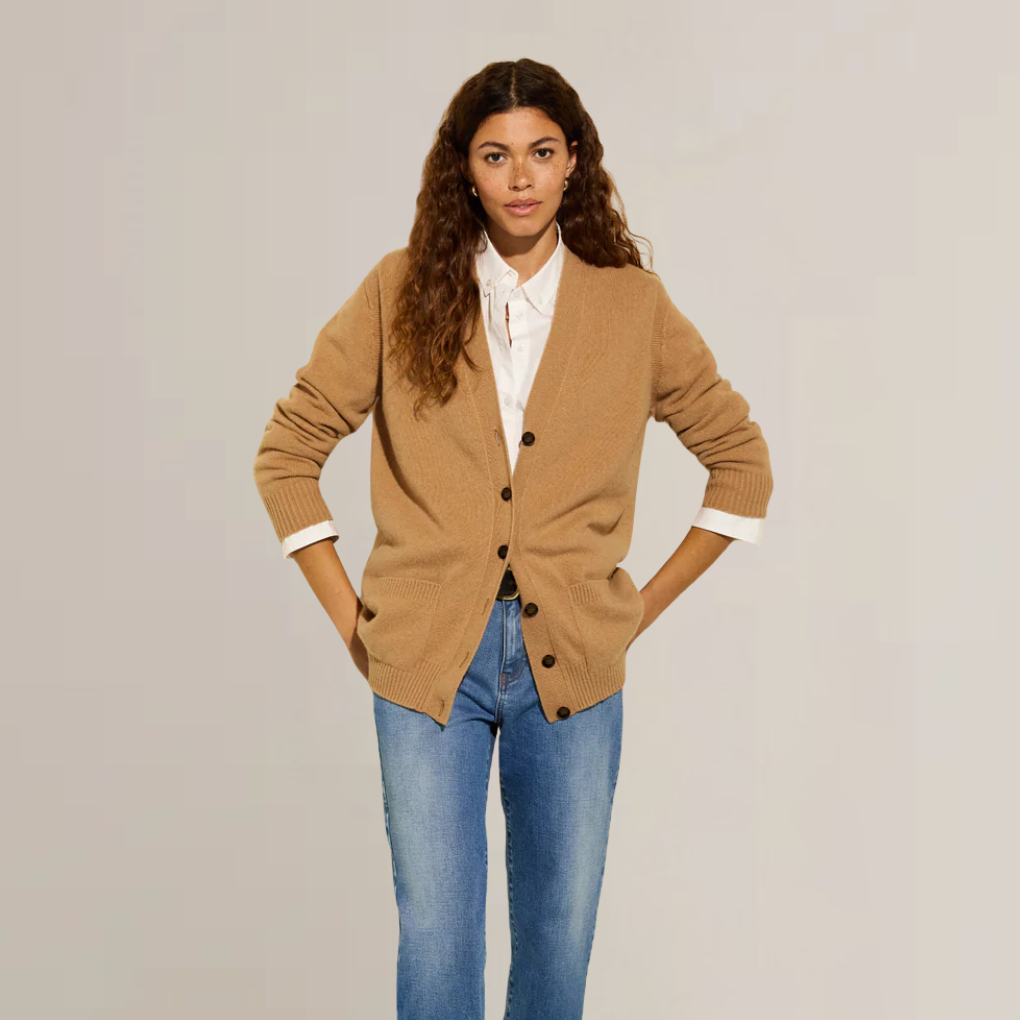
Sustainable sweaters for fall are the perfect way to welcome crisp mornings and cozy evenings, keeping you warm while supporting your values.
The future of sustainable fashion lies in giving discarded textiles new life, transforming factory scraps and post-consumer garments into the soft, luxurious sweaters we crave for fall layering.
Why Choose Recycled Material Sweaters?
Recycled material sweaters offer a sustainable alternative to traditional wool and cashmere without sacrificing quality or comfort. Here are five compelling reasons to choose them:
1. Dramatic Environmental Impact Reduction. Recycled sweaters prevent textile waste from reaching landfills and significantly reduce water consumption, chemical processing, and resource extraction compared to virgin fiber production.
2. Preserved Luxury and Quality Modern recycling techniques maintain the softness, breathability, and temperature regulation properties of premium fibers, ensuring recycled sweaters perform just as well as virgin alternatives.
3. Better Value for Money Recycled material sweaters typically cost less than virgin fiber options while delivering the same luxury feel and durability, making premium materials more accessible.
4. Ecosystem and Wildlife Protection By reducing demand for new fiber production, recycled sweaters help prevent overgrazing and habitat destruction in vulnerable regions like Mongolia and Afghanistan.
5. Support for Textile Innovation The recycled sweater market drives advances in fiber processing technology, often resulting in enhanced product features like improved colorfastness and unique material blends.
What Counts as a “Recycled Sweater”?
When a sweater is labeled “recycled,” it can refer to several different types of materials, each with its unique history. Some start as fabric scraps left behind in factories.
Others come from old garments that have been broken down and re-spun into something new. Here’s a quick breakdown of the most common types used in fall sweaters.
Recycled Wool
Most recycled wool is mechanically processed, which means it’s made from old wool sweaters, secondhand clothing, or pre-consumer scraps. These materials are sorted by color and fiber content, then shredded into fibers and spun into new yarn.
This method avoids harsh chemical treatments and helps preserve fiber quality. Some recycled wool is blended with a small percentage of virgin wool to improve durability, especially in sweaters that need to hold their shape over time.
Recycled Cashmere
Cashmere can also be mechanically recycled, but because the fibers are finer and more delicate than wool, the process requires extra care. Recycled cashmere often comes from post-consumer garments collected through take-back programs or secondhand markets. Like recycled wool, it may be blended with virgin fibers to improve strength without sacrificing softness.
Recycled Polyester
Recycled polyester is typically made from PET plastic bottles or synthetic textile waste. The plastic is cleaned, melted, and reformed into new fibers that can be knit or woven into fabric.
While it’s still a synthetic material, using recycled polyester keeps plastic out of landfills and reduces demand for fossil fuel-based virgin polyester. Some sweaters combine recycled polyester with natural or recycled fibers to balance stretch, durability, and softness.
Blended Materials
It’s common to see recycled fibers blended with virgin ones, like 70 percent recycled wool with 30 percent organic cotton. These blends help improve the garment’s performance and lifespan while still significantly reducing environmental impact compared to entirely virgin materials. Always check the label to see the breakdown and aim for the highest possible percentage of recycled content.
Related Article: What Is Recycled Polyester? A Closer Look at This Eco-Friendly Fabric
Recycled vs. Organic vs. Conventional Materials: What’s Best for Fall?
Choosing a cozy fall sweater isn’t just about the cut or color; it’s also about what it’s made from. Here’s a quick breakdown of the pros and cons of the three most common material types: recycled fibers, organic options, and conventional (virgin) wool and cashmere.
Examples: recycled wool, recycled cashmere, recycled polyester
Recycled Materials
Pros:
- Dramatically lower environmental impact
- Keeps textile waste out of landfills
- Often requires less water, energy, and dye
- Supports circular fashion systems
Cons:
- Fibers can be shorter, which may affect softness or strength
- Often blended with small amounts of virgin material for durability
- Limited color ranges unless redyed
Examples: organic cotton, organic alpaca, organic wool
Organic Fibers
Pros:
- Grown without synthetic pesticides or fertilizers
- Better for soil health and farmworker safety
- Often softer than conventional versions
- Biodegradable and natural
Cons:
- Still resource-intensive (mainly cotton, which uses a lot of water)
- Can be expensive
- Organic doesn’t always mean ethical or low-emissions (look for complete transparency)
Conventional material
Virgin Wool and Cashmere
Pros:
- Warm, breathable, and naturally insulating
- Long-lasting when well cared for
- Often considered a luxury material
Cons:
- High environmental footprint, especially virgin cashmere
- Requires large amounts of land, water, and grazing animals
- Can contribute to overgrazing and habitat loss
- Chemical processing is standard unless certified otherwise
The Takeaway
For everyday layering that’s warm and lower impact, recycled materials are a strong choice. Organic options are a good alternative when recycling isn’t available, especially if certified by reputable standards. Virgin materials should be chosen thoughtfully, ideally from brands that prioritize animal welfare and responsible sourcing.
27 Sustainable Sweaters for Fall
Note: The material breakdown provided applies only to the main sweater featured from each brand.
Tentree
$71-110
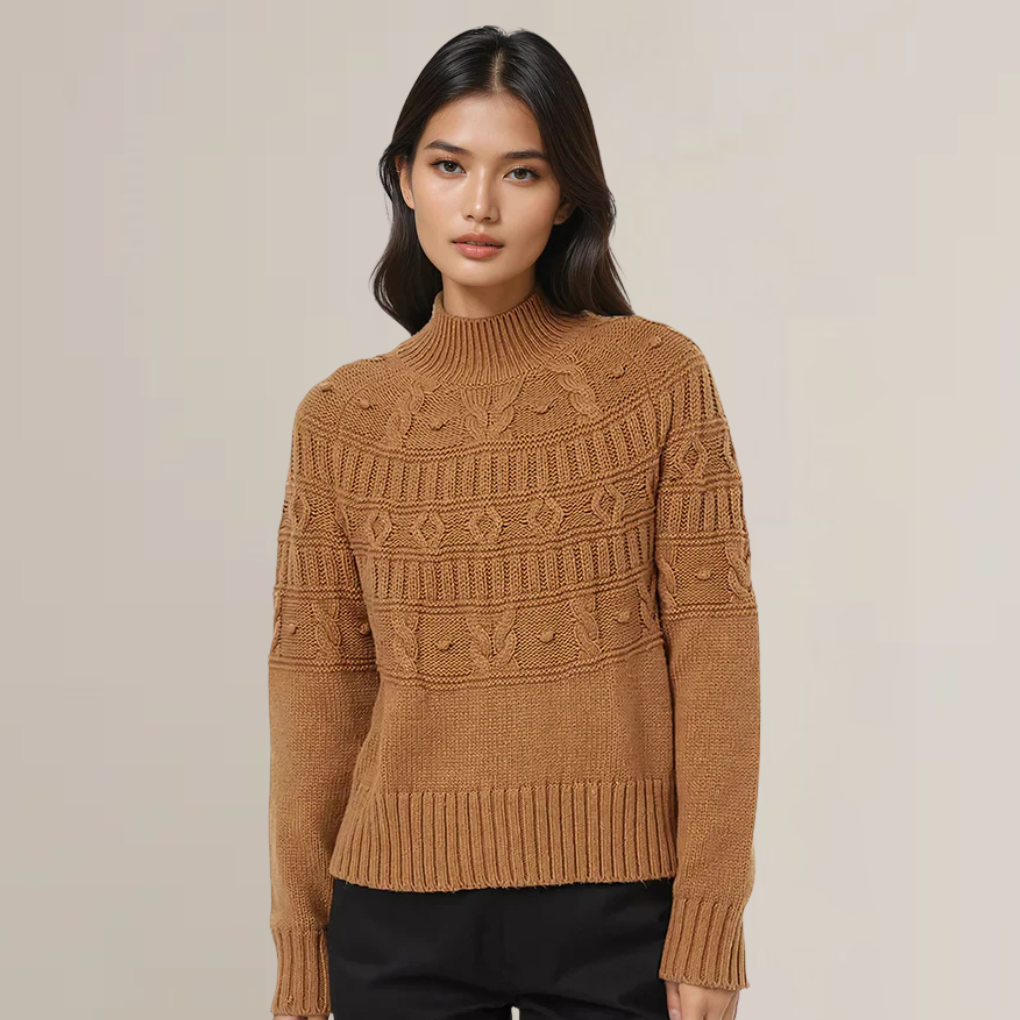
A Canadian sustainable apparel brand founded in 2012 in Regina by entrepreneurs Kalen Emsley, Derrick Emsley, and David Luba.
Tentree describes itself as a tree-planting company first and an ethical clothing company second, planting 10 trees for every item purchased, with the goal of planting 1 billion trees by 2030.
The brand is certified by Worldwide Responsible Accredited Production (WRAP) and follows the Business Social Compliance Initiative Code of Conduct for ethical manufacturing.
Why we love them
- 99% of their materials are sustainable fibers, to phase out the remaining 1% of conventional fibers
- Certified B Corporation since 2016 with one of the highest scores (136.2) among apparel companies globally
- Climate Label certified (formerly Climate Neutral), committing to track, report, and reduce emissions annually
- 44% of materials are fiber-to-fiber closed-loop recyclable, aiming for 100% by 2030
- Material: 44% Recycled Polyester, 30% Organic Cotton, 26% Wool
- Certifications: Responsible Wool Standard (RWS) certified for any wool used, Global Recycled Standard (GRS) for recycled materials, B Corporation
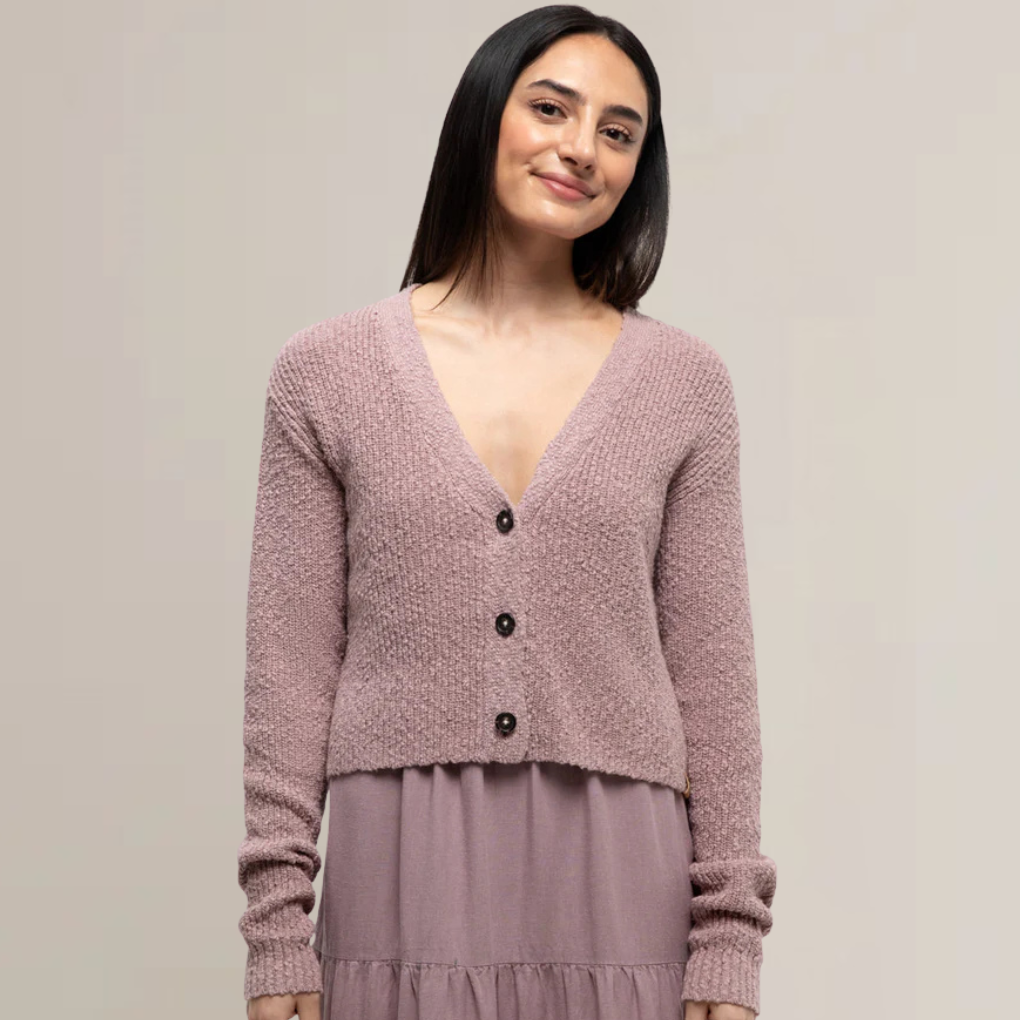
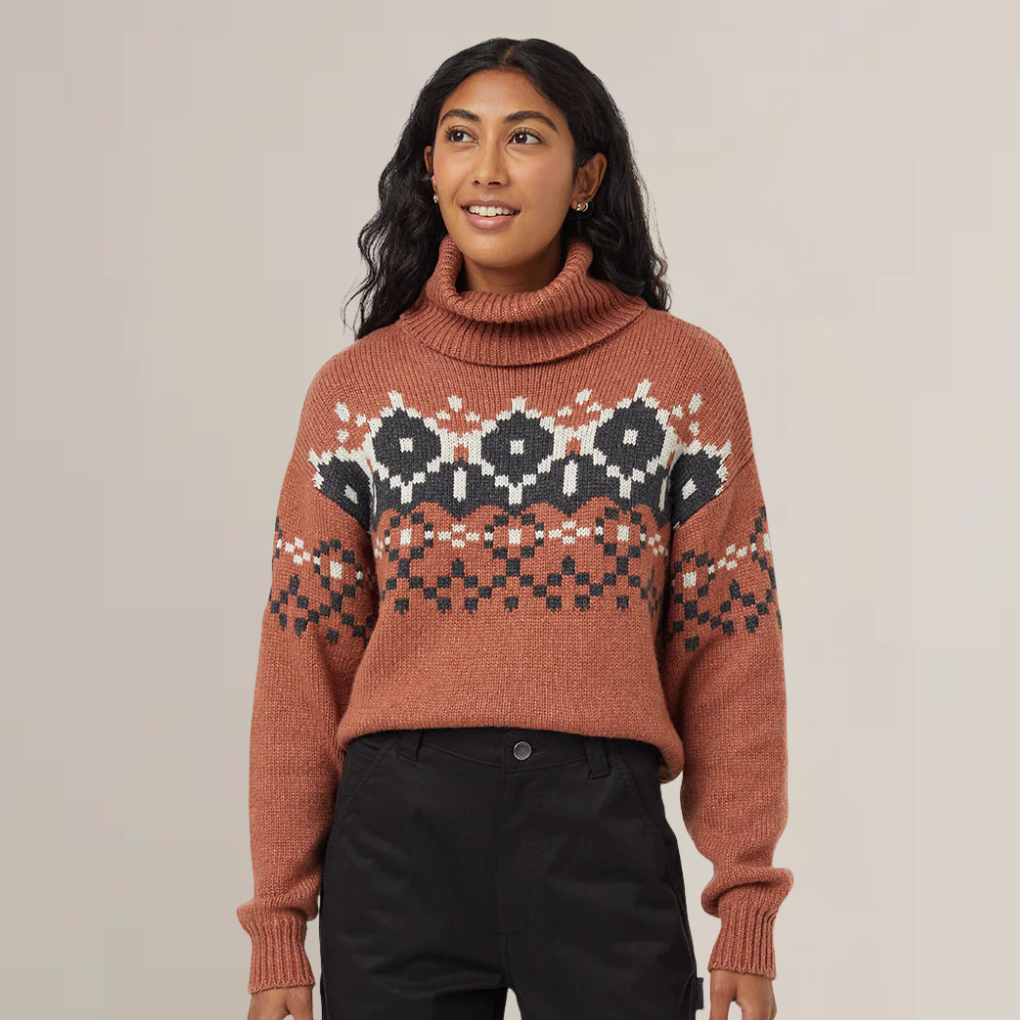
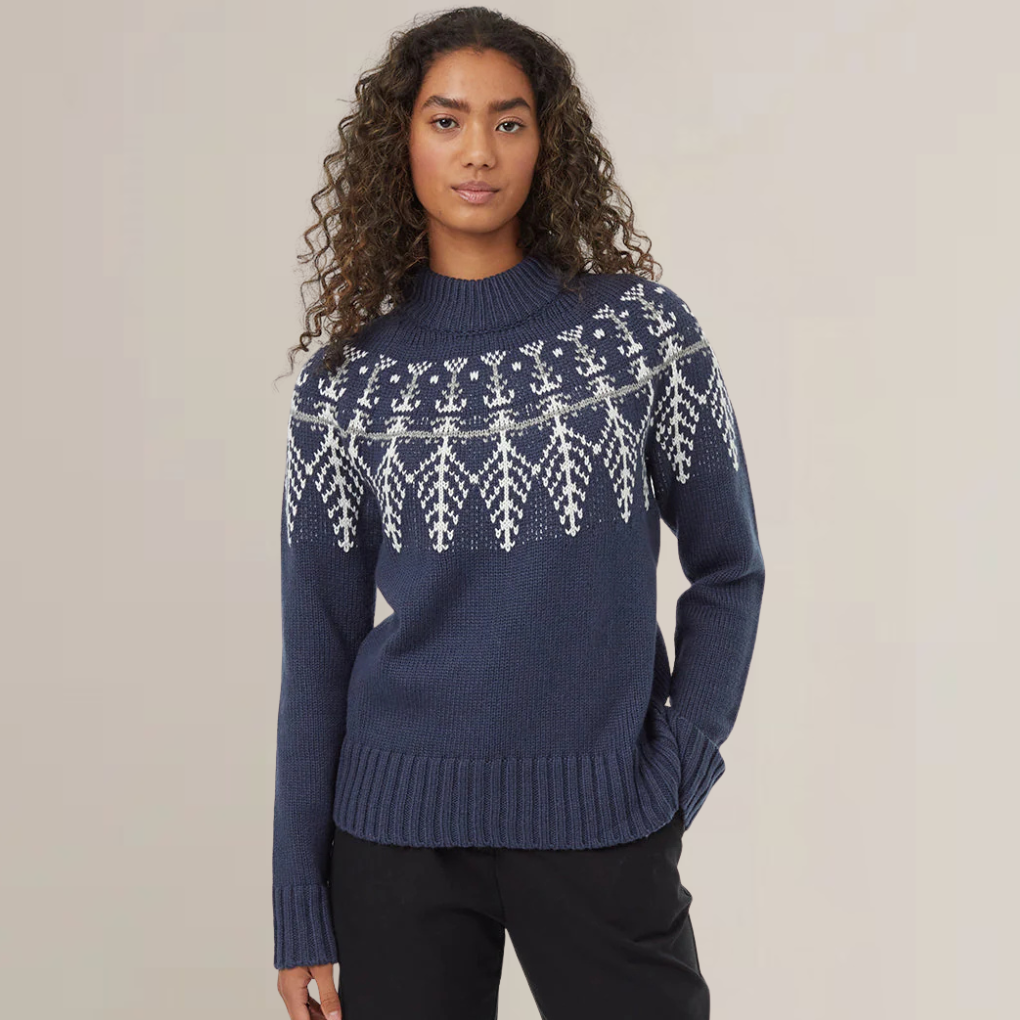
Baukjen
$162-230
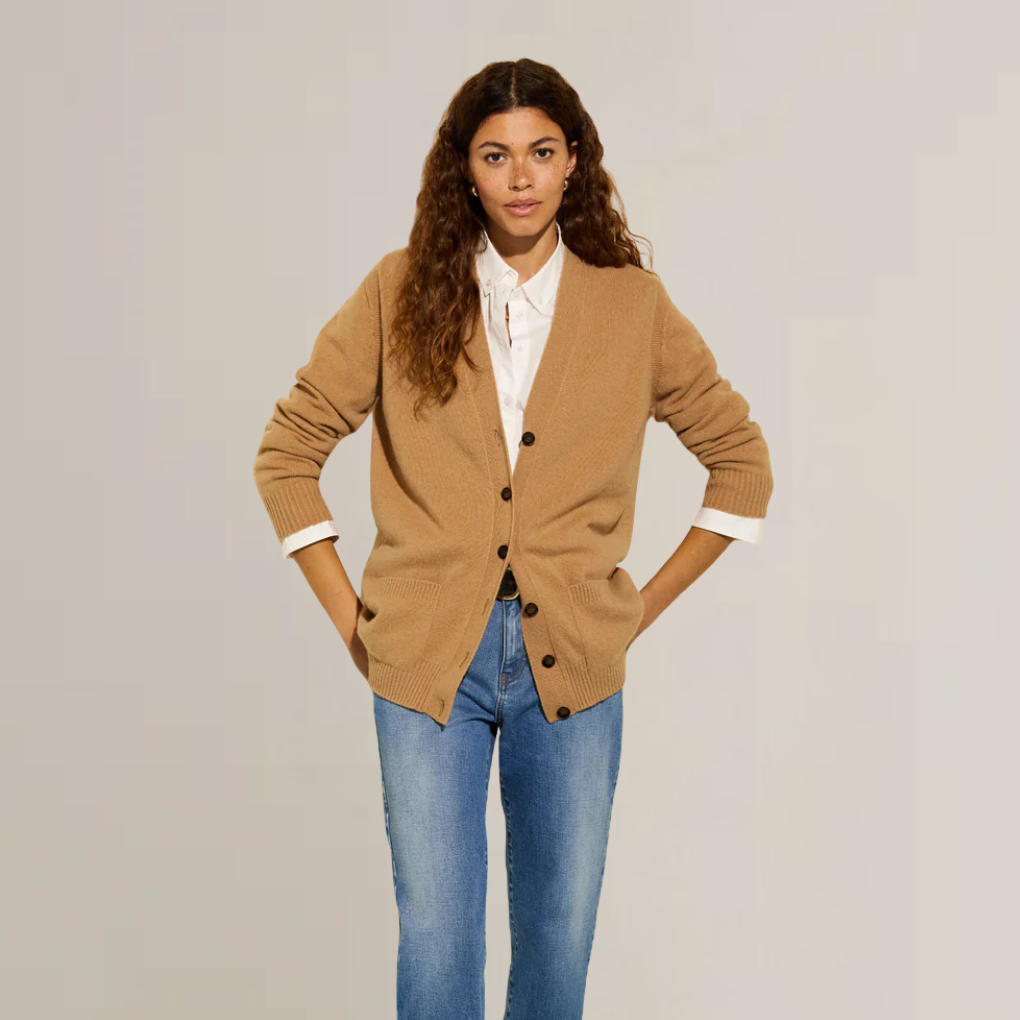
A London-based sustainable womenswear brand founded in 2012 by Dutch entrepreneur Baukjen de Swaan Arons and her husband Geoff van Sonsbeeck.
The family-run business operates under the motto “Designed for Good,” focusing on environmentally, ethically, and socially conscious style for a sustainable future.
Why we love them
- Highest scoring SME Fashion B Corp in the world with 153.6 points (2024)
- UN Global Climate Action Award winner for carbon-neutral leadership
- 99.4% of products are made from responsible fibers with complete transparency
- Circular fashion initiatives, including a rental service and a take-back program for recycling
- 10% of annual profits donated to charity, with periodic campaigns donating up to 50%
- 100% recyclable packaging and renewable energy-powered warehouse
- Material: 100% Recycled Extrafine Wool
- Certifications: Certified B Corporation, Responsible Wool Standard (RWS)
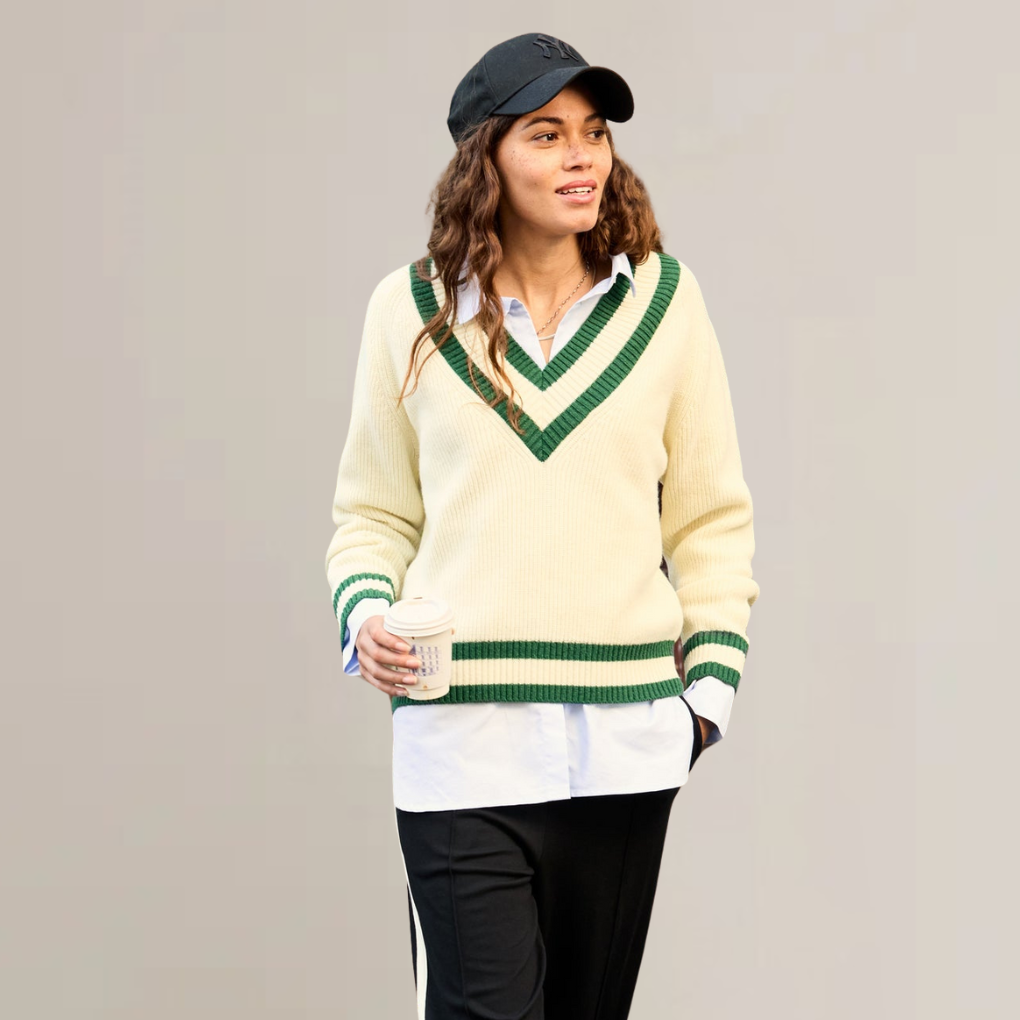
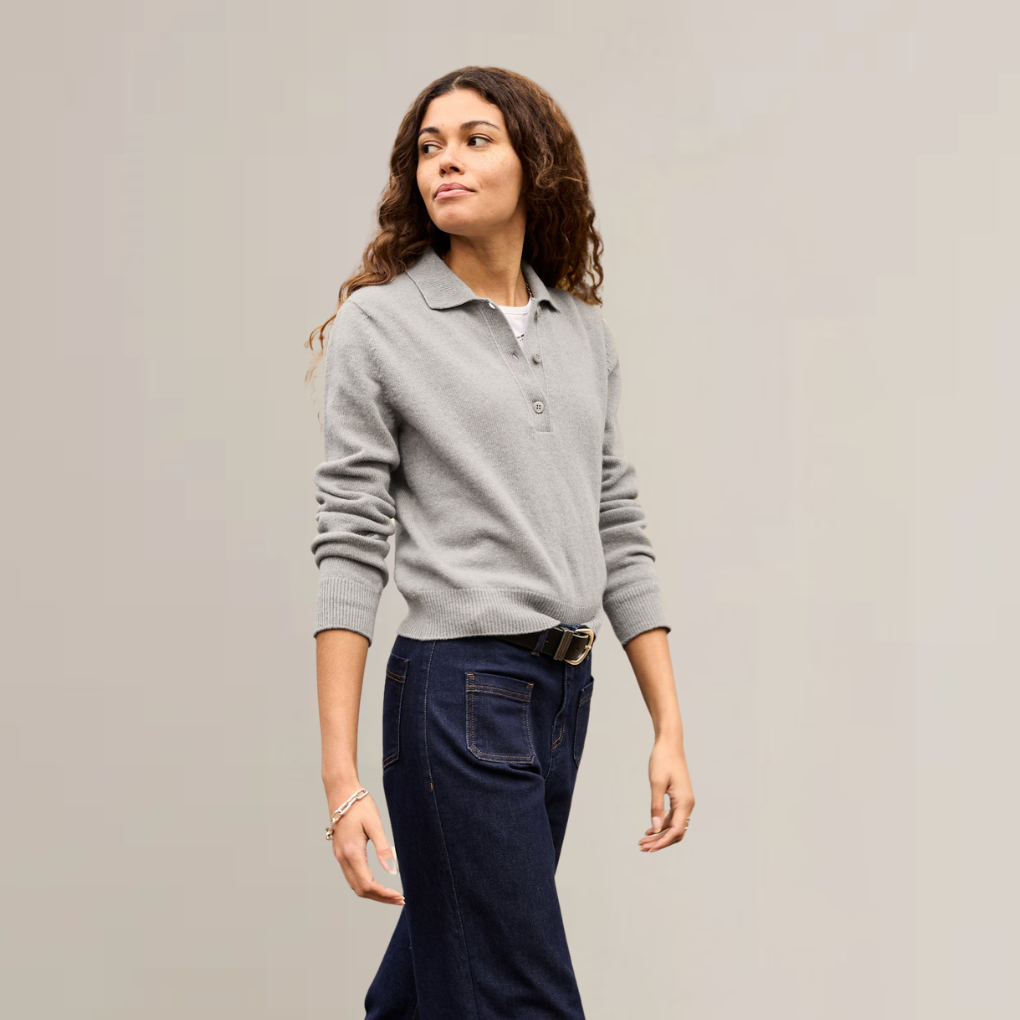
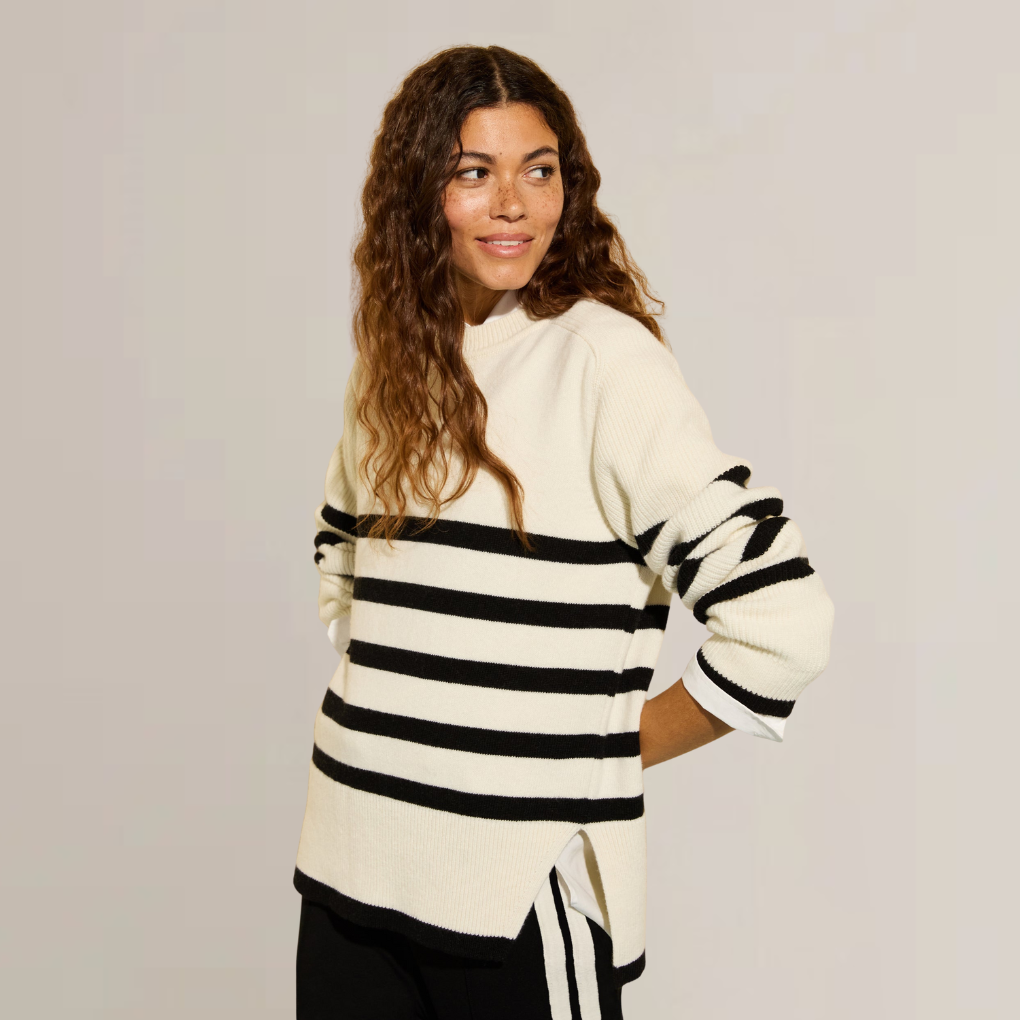
Reformation
$178-298
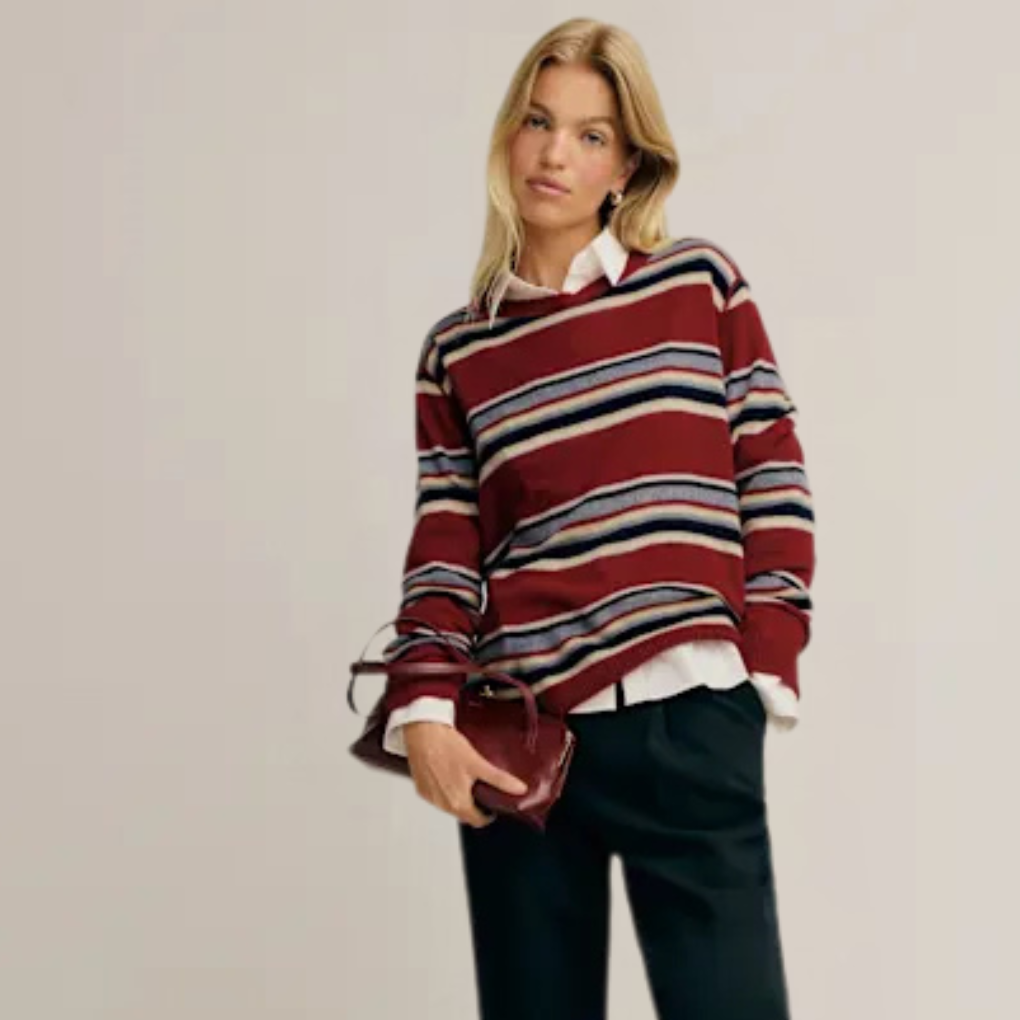
Reformation is a Los Angeles-based sustainable fashion leader known for transforming eco-friendly materials into trendy, Instagram-worthy pieces.
Founded with sustainability at its core, the brand has built a reputation for making environmental responsibility fashionable.
Why we love them
- Climate Neutral Certified company
- Transparent environmental impact reporting (shows water and CO2 saved per piece)
- Circularity commitment with take-back programs
- “RefRecyclable” program for reusing, reselling, and recycling
- Material: 95% recycled cashmere, 5% virgin cashmere.
- Certifications: Climate Label Certification, Fair Labor Association (FLA) Code of Conduct
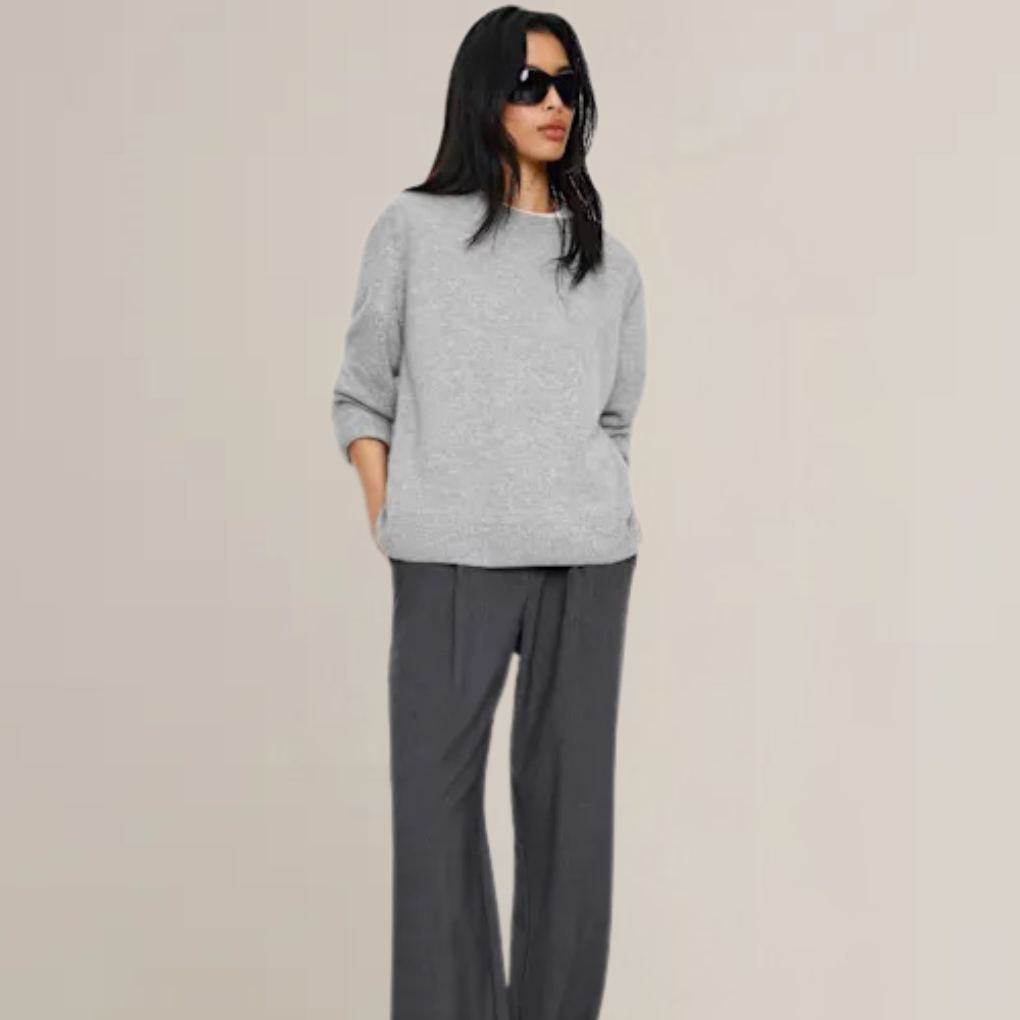
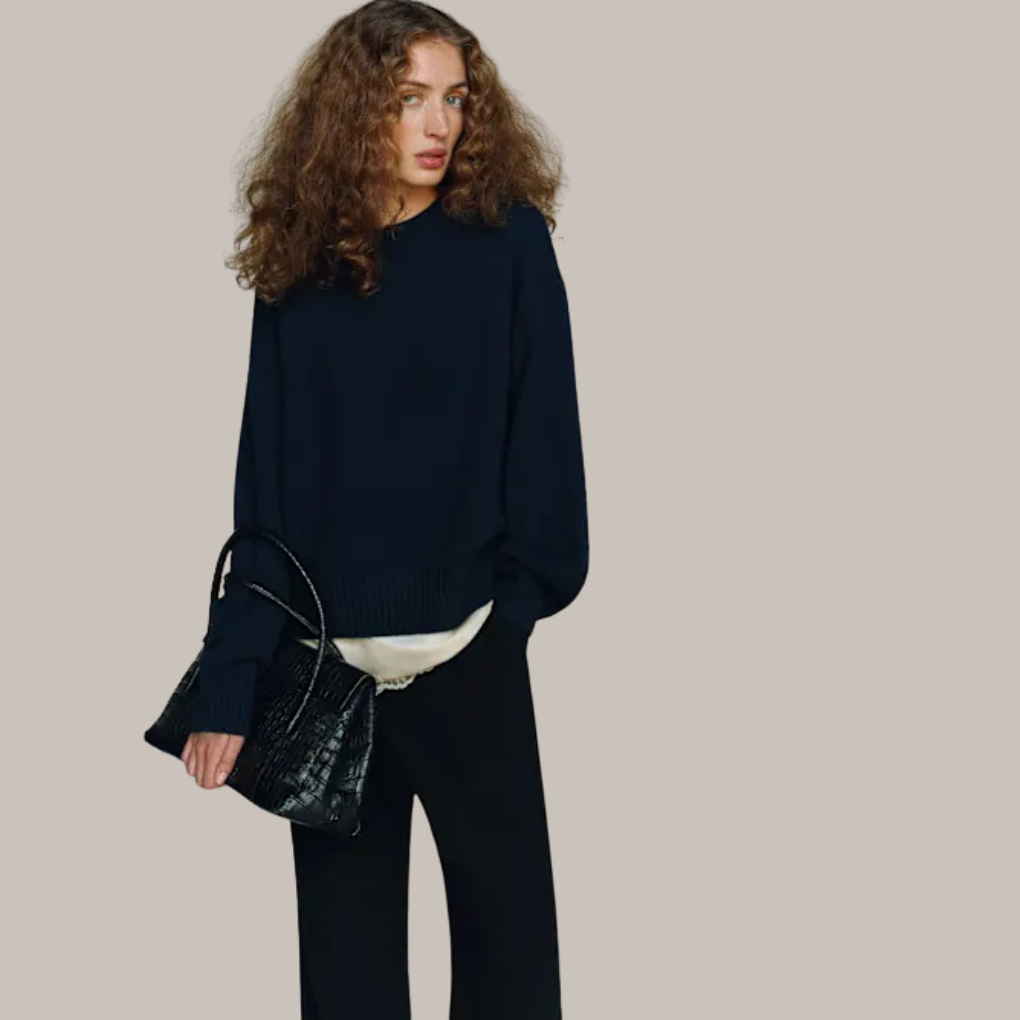
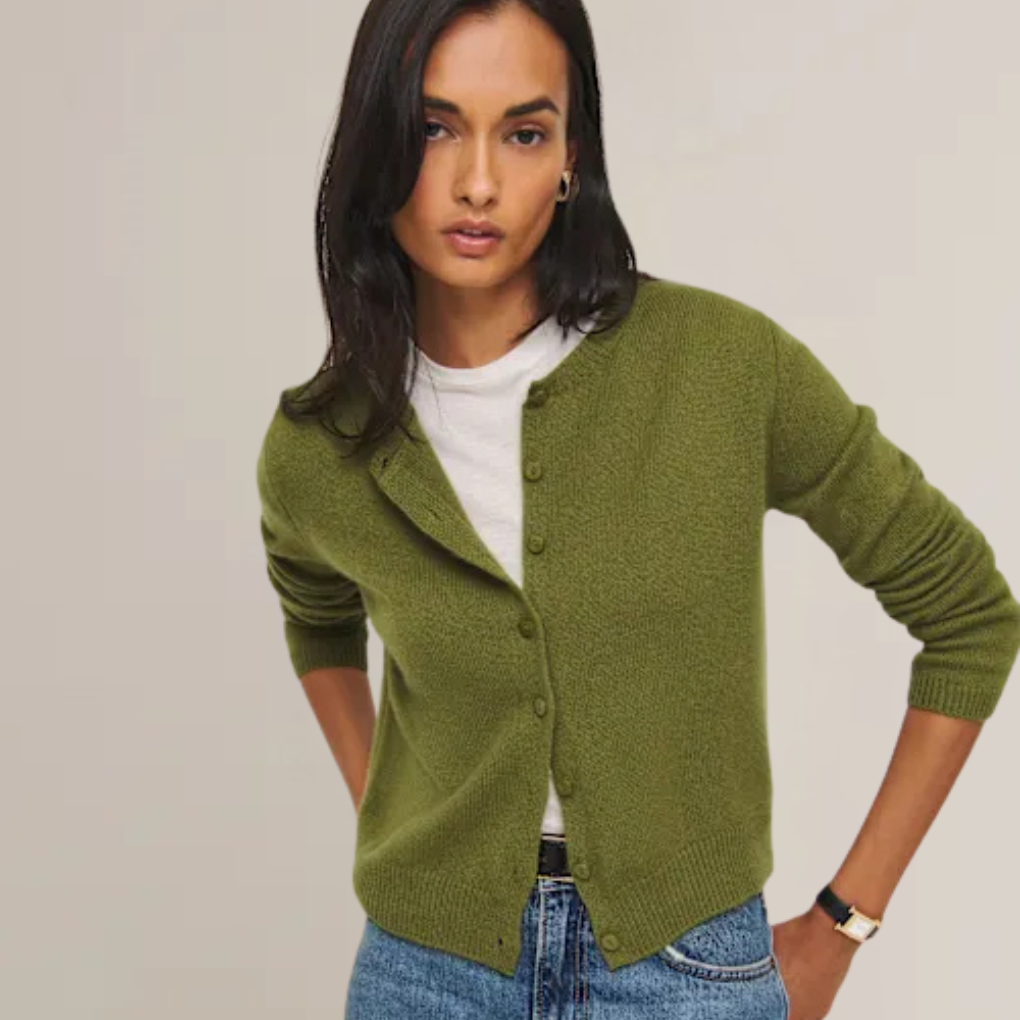
Colorful Standard
$105-168
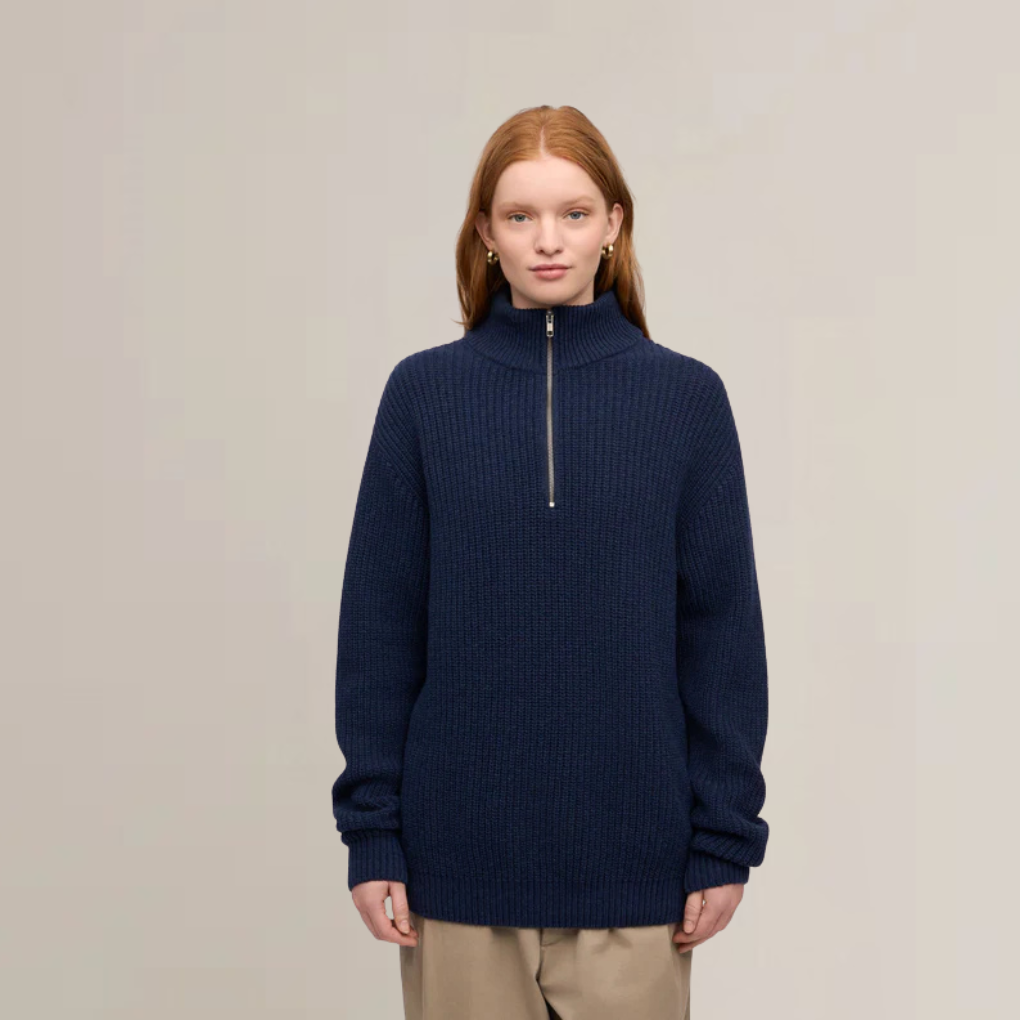
A Danish brand founded in 2017 by entrepreneur Tue Deleuran, headquartered in Copenhagen. Colorful Standard focuses on essential wardrobe staples made from sustainable materials.
They manufacture all products at their in-house production center in Portugal, allowing them to maintain high European labor standards while leveraging local textile expertise and keeping production transparent, with factory visits welcome.
Why we love them
- Zero waste production philosophy
- Uses organic cotton and recycled materials exclusively
- Pre-washed garments to prevent shrinkage
- Focus on essentials that transcend seasonal trends
- Carbon neutral shipping
- Material: 100% recycled extra-fine merino wool
- Certifications: Global Recycled Standard (GRS) certified, Oeko-Tex® certified dyes (no harmful chemicals)
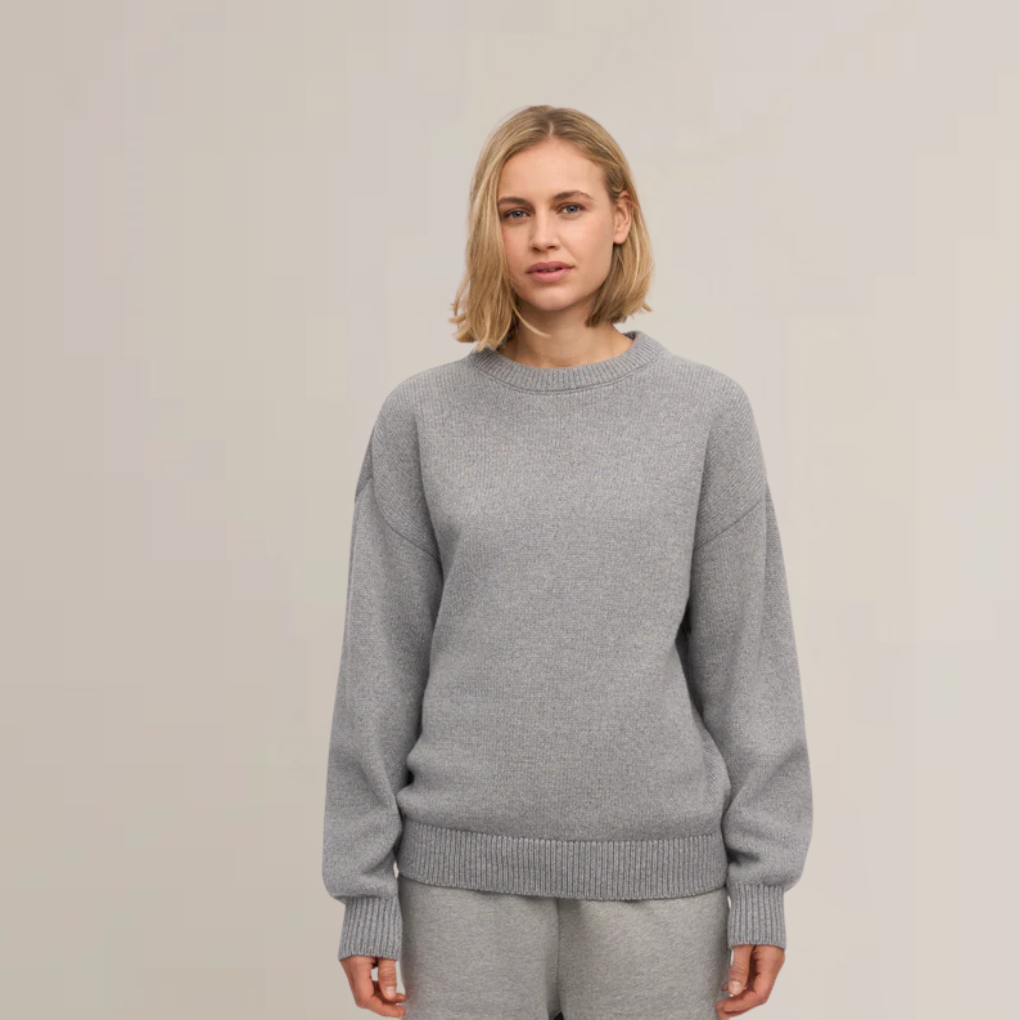
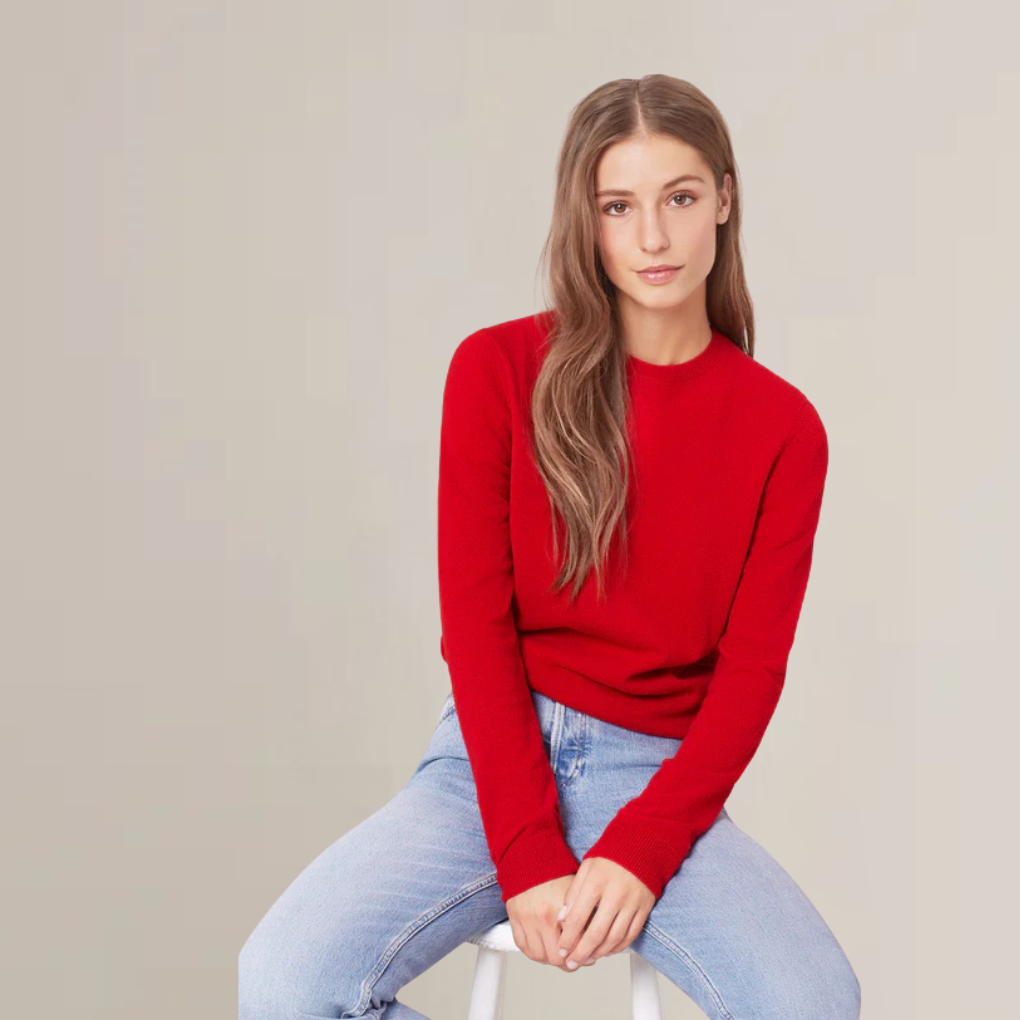
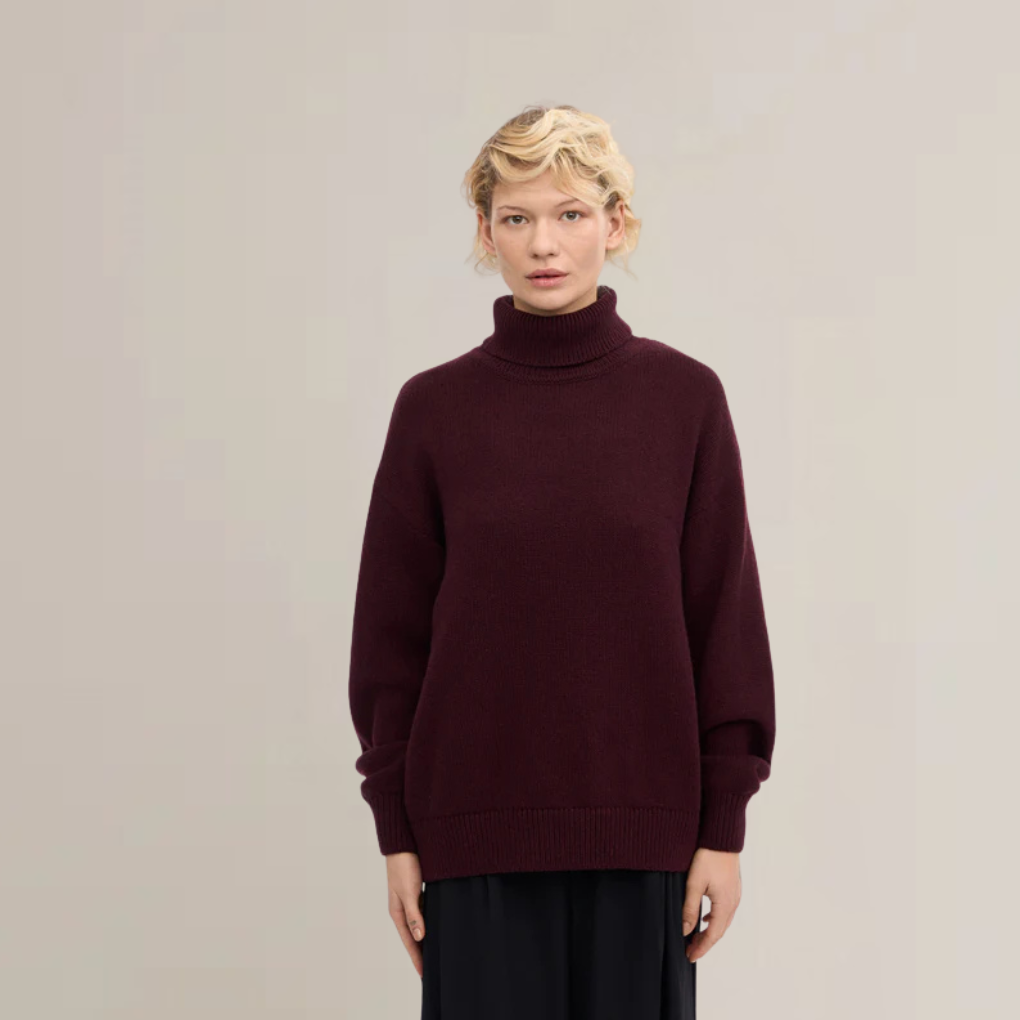
Patagonia
$174-208
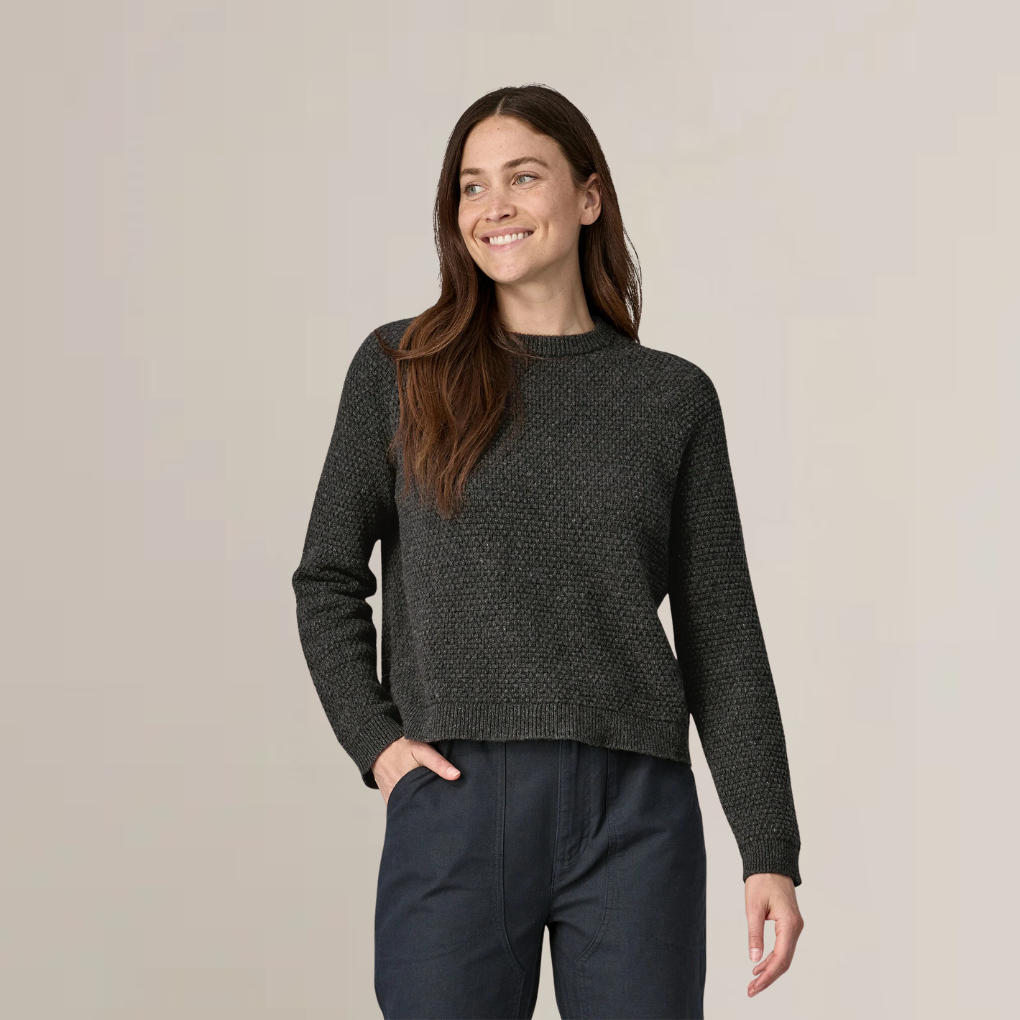
An American outdoor apparel company founded in 1973 in Ventura, California, by rock climber and environmental activist Yvon Chouinard.
What began as one man making climbing gear for friends has evolved into a globally recognized billion-dollar brand committed to using business as a force for environmental good.
In 2022, Chouinard transferred ownership to the Patagonia Purpose Trust and Holdfast Collective nonprofit, ensuring all future profits go toward fighting climate change.
Why we love them
- Certified B Corporation since 2012 with “Earth is now our only shareholder” philosophy
- 1% for the Planet founding member – donates 1% of sales annually (over $100 million since 1985)
- Worn Wear program offers lifetime repairs, trade-ins, and resale to extend product life
- 72% of product line uses recycled materials, including recycled polyester and nylon
- Carbon-neutral commitment by 2025 with comprehensive supply chain transparency
- ReCrafted program creates new clothing from fabric scraps of used Patagonia gear
- Material: 95% recycled cashmere and 5% wool blend
- Certifications: Certified B Corporation, 1% for the Planet member, Fair Trade Certified manufacturing, Responsible Wool Standard (RWS) for virgin wool components, bluesign® approved fabrics
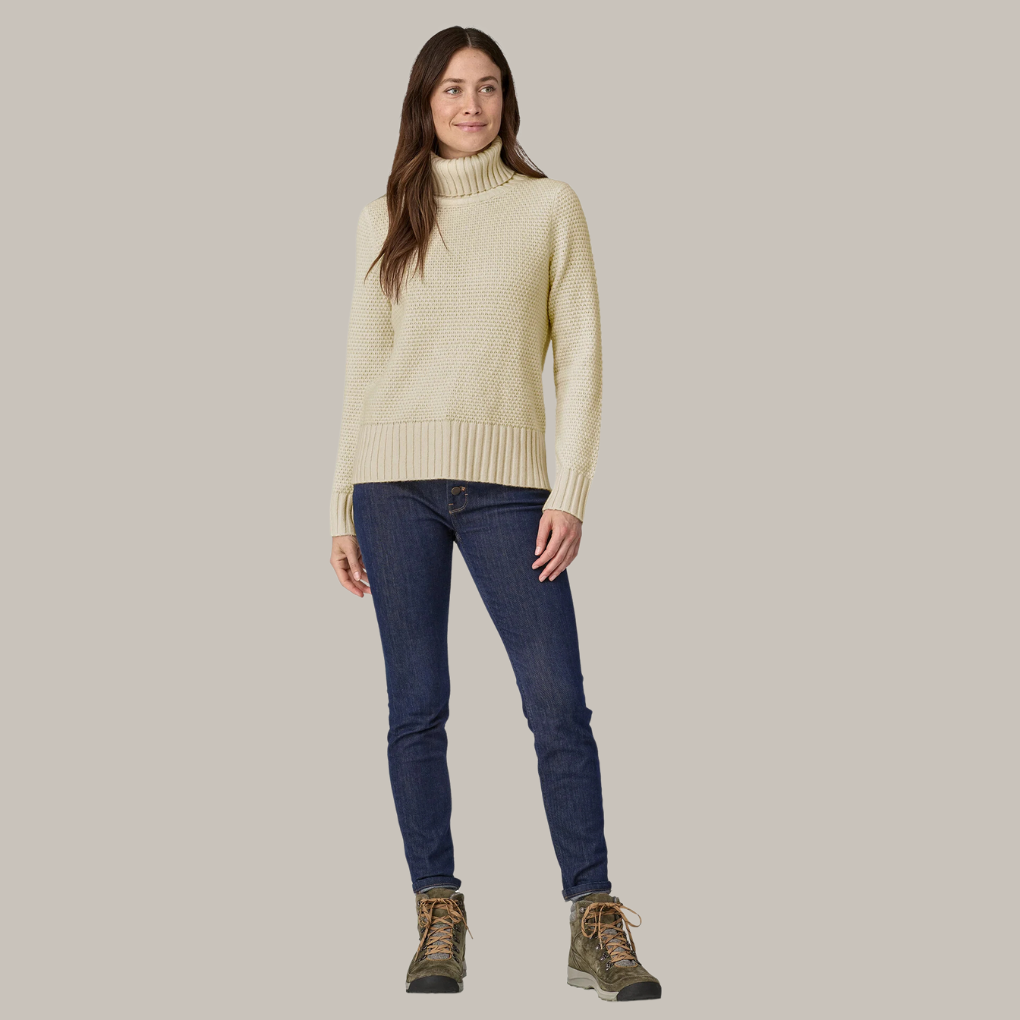
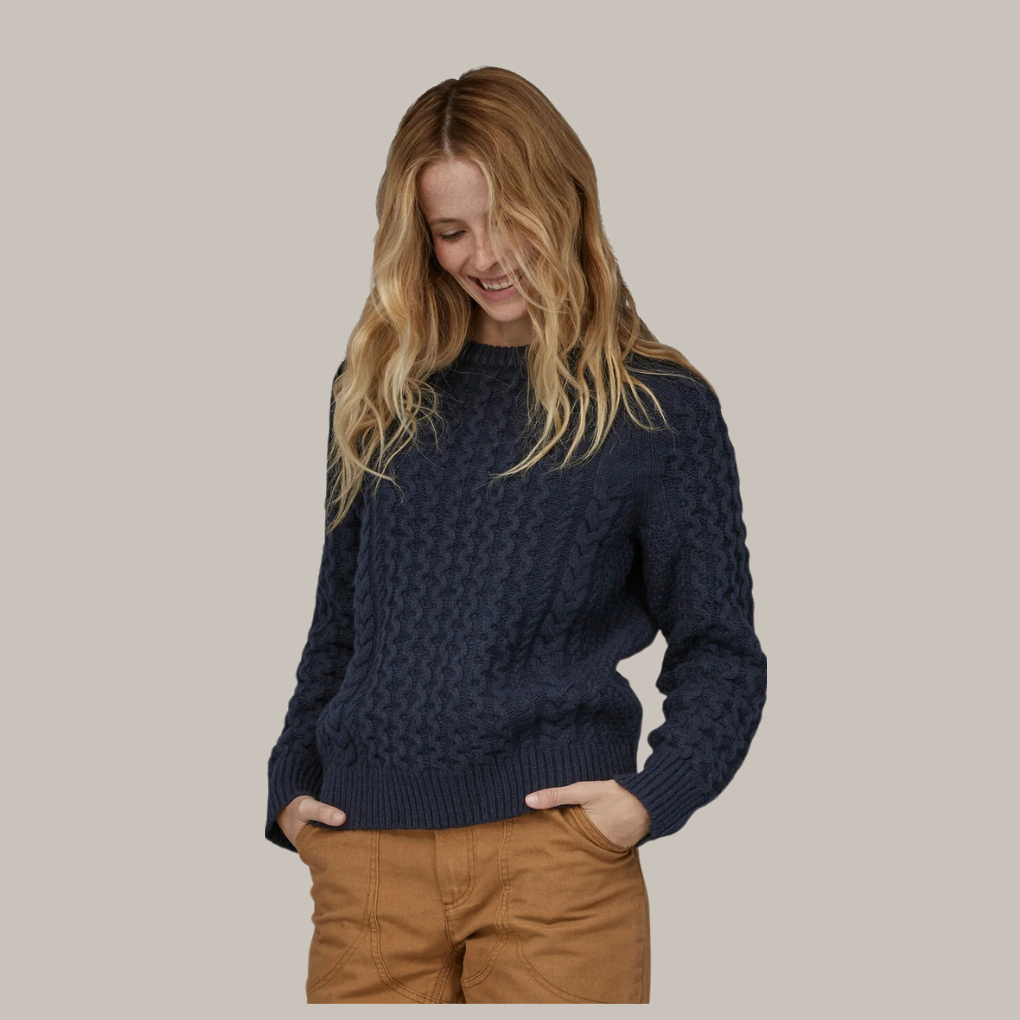
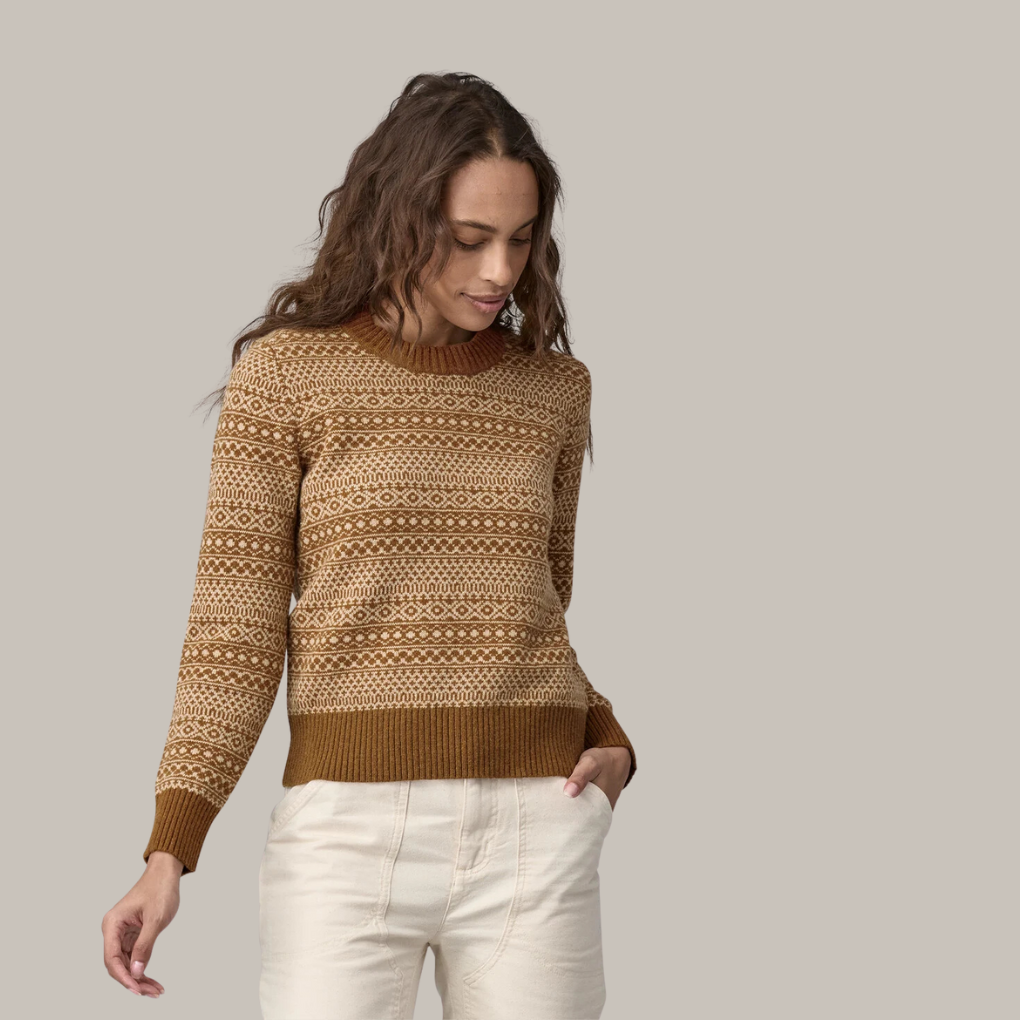
Asket
$250
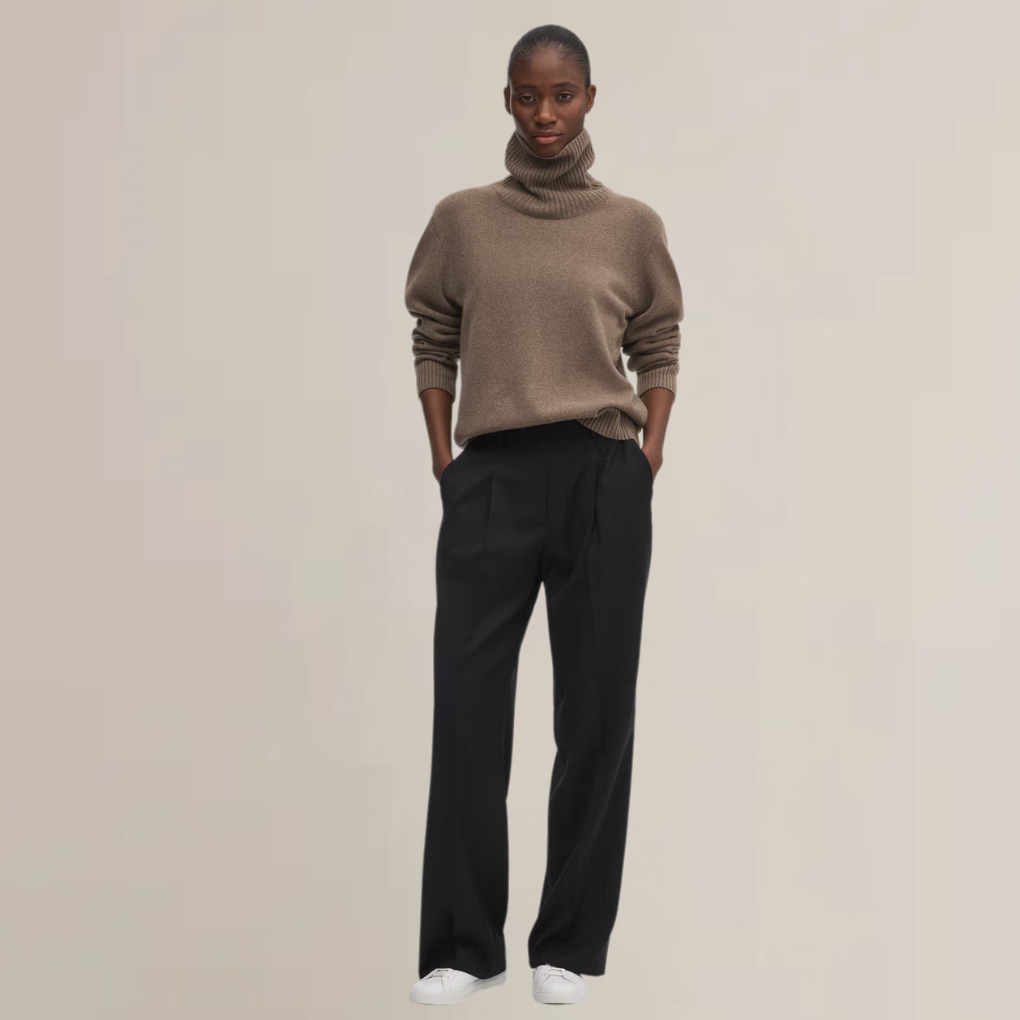
A Swedish sustainable fashion brand founded in 2015 in Stockholm by entrepreneurs August Bard Bringéus and Jakob Dworsky, who met at the Stockholm School of Economics.
The brand operates on “The Pursuit of Less” philosophy, creating a permanent collection of timeless wardrobe essentials rather than following seasonal trends.
Why we love them
- Permanent collection philosophy – no seasons, sales, or trend-driven design changes
- Complete supply chain transparency with traceability goals of 100% by 2030
- Revival program accepts returned garments for resale, remanufacturing, or recycling
- Stockholm’s flagship store plus “Asket Restore” location for secondhand and upcycled pieces
- Material: 97% recycled cashmere, 3% recycled wool.
- Certifications: Global Recycled Standard (GRS) certified, Responsible Wool Standard (RWS) certified, OEKO-TEX certified, Certified B Corporation, Climate Neutral Certified (formerly Climate Neutral)
Cuyana
$278
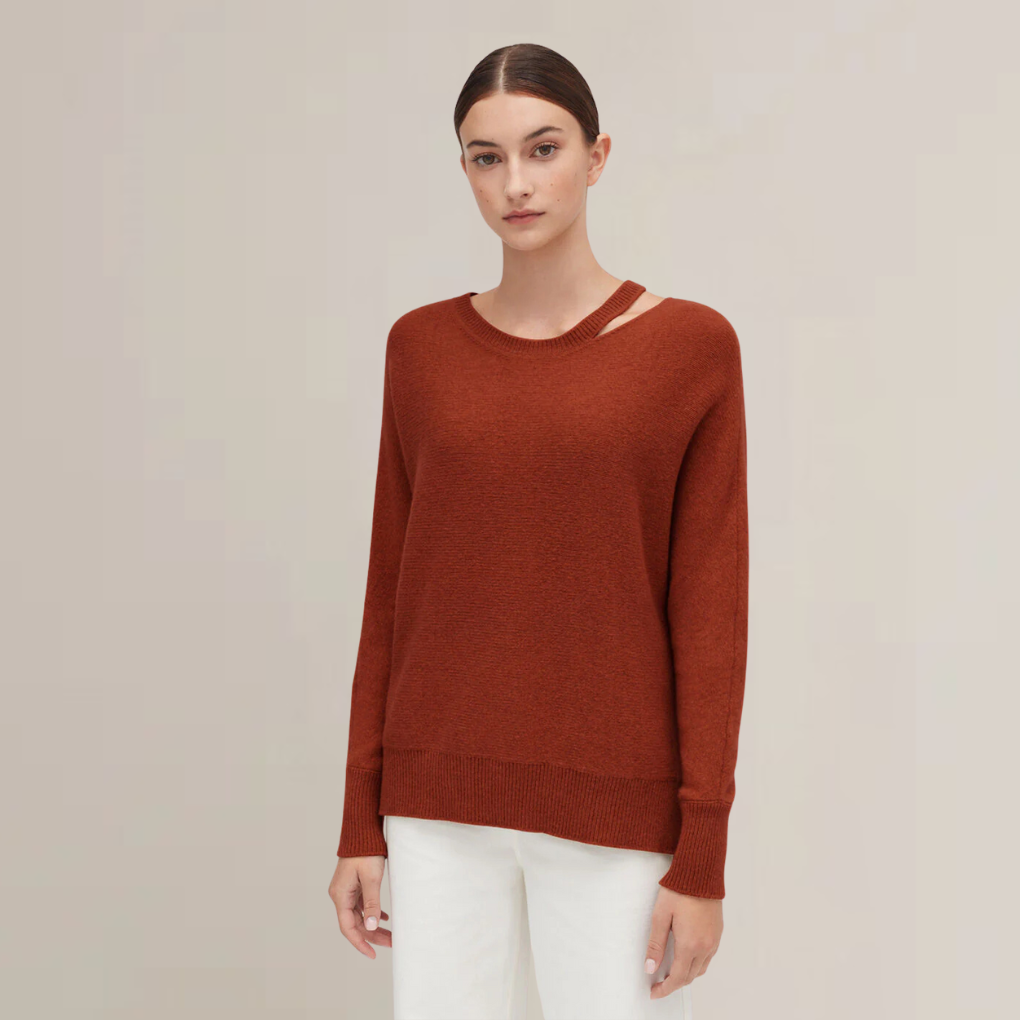
A San Francisco-based sustainable fashion brand founded in 2011 by entrepreneurs Karla Gallardo (from Ecuador) and Shilpa Shah, who met at Stanford Business School.
The brand name “Cuyana” derives from the Quechua word meaning “to love,” reflecting their philosophy of encouraging customers to love what they own through the “Fewer, Better” ethos.
They partner with heritage craftspeople globally, including a 130-year-old family-run mill outside Bologna, Italy, for their recycled cashmere. The brand designs all pieces in San Francisco with a focus on timeless minimalism.
Why we love them
- “Fewer, Better” philosophy promoting intentional consumption over fast fashion
- 100% of collection made from sustainably-certified materials (achieved 2022 goal)
- Global Recycled Standard (GRS) certified recycled cashmere from an Italian mill
- Lean Closet Program allows customers to exchange gently-used items for credit
- Cuyana Revive resale platform extends product lifecycles
- H.E.A.R.T. program prevents items from reaching landfills through second-life initiatives
- Carbon-neutral shipping with offset programs
- Material: 98% Recycled Cashmere, 2% Virgin Wool
- Certifications: Global Recycled Standard (GRS), Greenpeace Detox Solution Agreement, Sustainably-Certified Materials Validatio
Everlane
$98-210
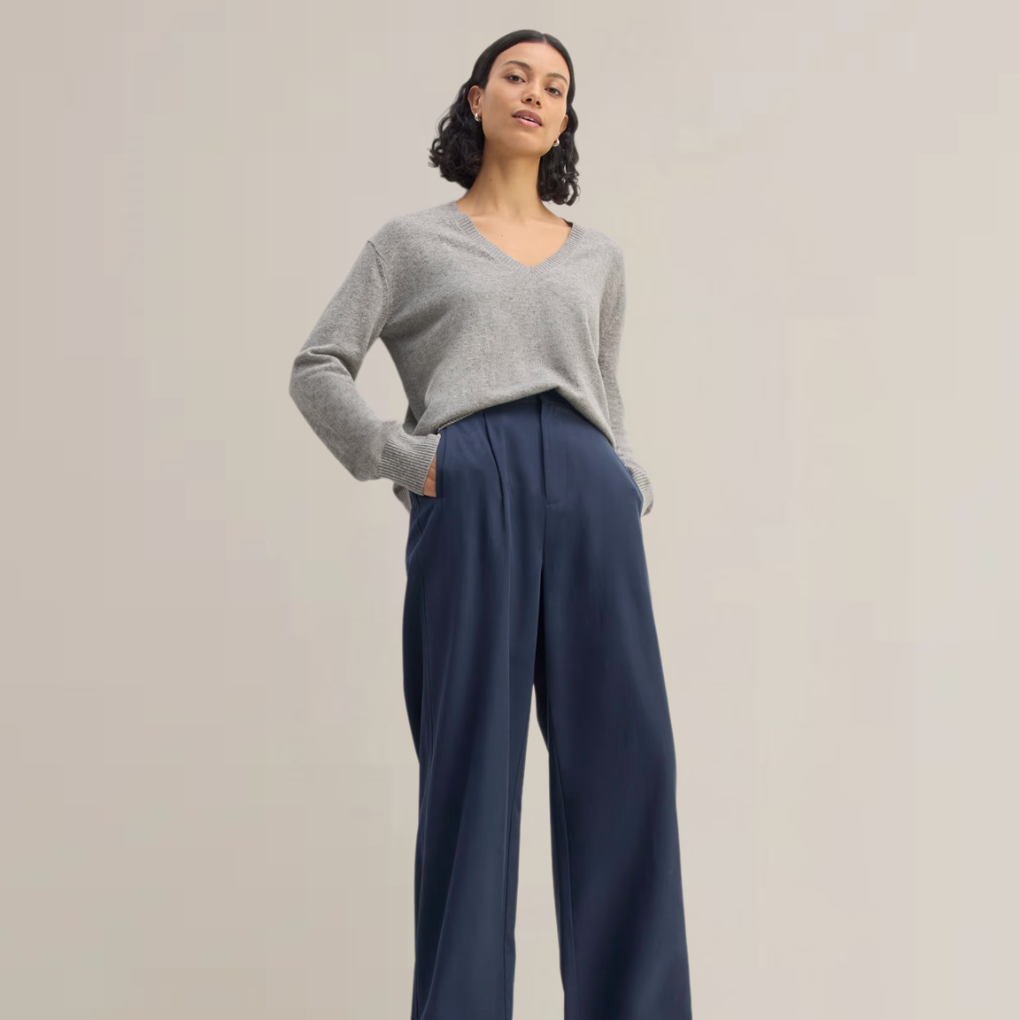
A San Francisco-based direct-to-consumer brand famous for “radical transparency” in pricing and manufacturing.
Everlane shows precisely how much each component of their garments costs, from materials to labor to transportation. Known for workplace-appropriate essentials.
Why we love them
- Transparent pricing showing material, labor, and transport costs
- Moving toward renewable and clean materials
- Animal welfare considerations in sourcing
- Factory transparency with detailed supply chain information
- Focus on timeless, versatile designs
- Material: 100% Cashmere (50% Recycled)
- Certifications: GRS-certified recycled cashmere (Global Recycled Standard), GCS-certified responsible cashmere (Good Cashmere Standard® by AbTF)
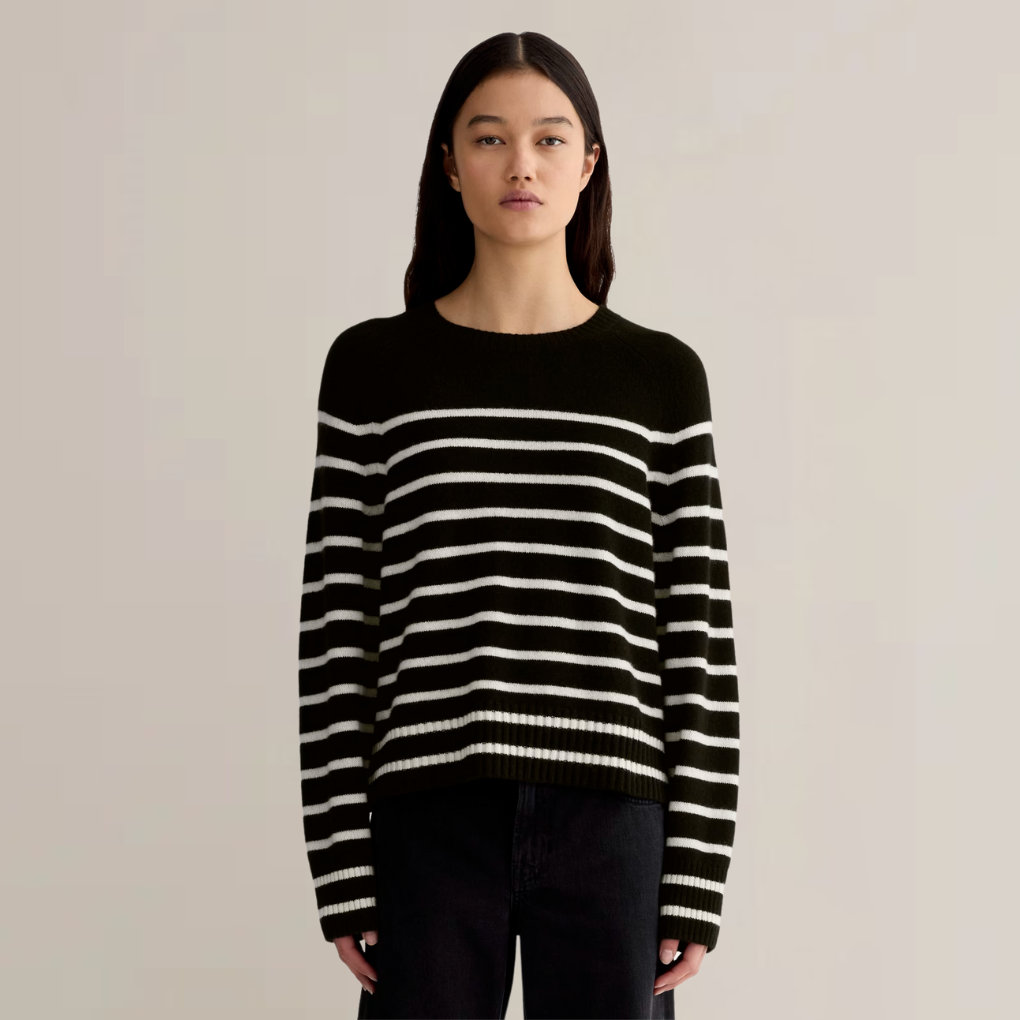
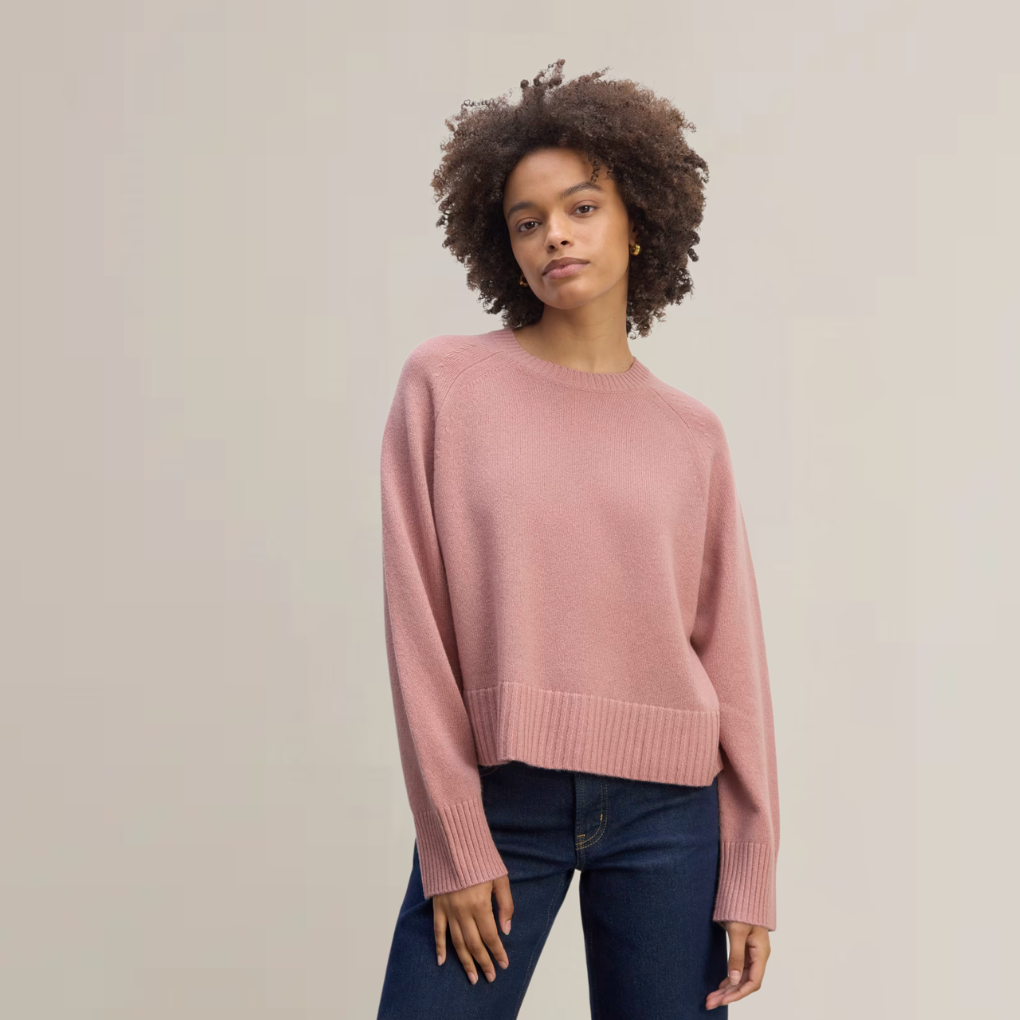
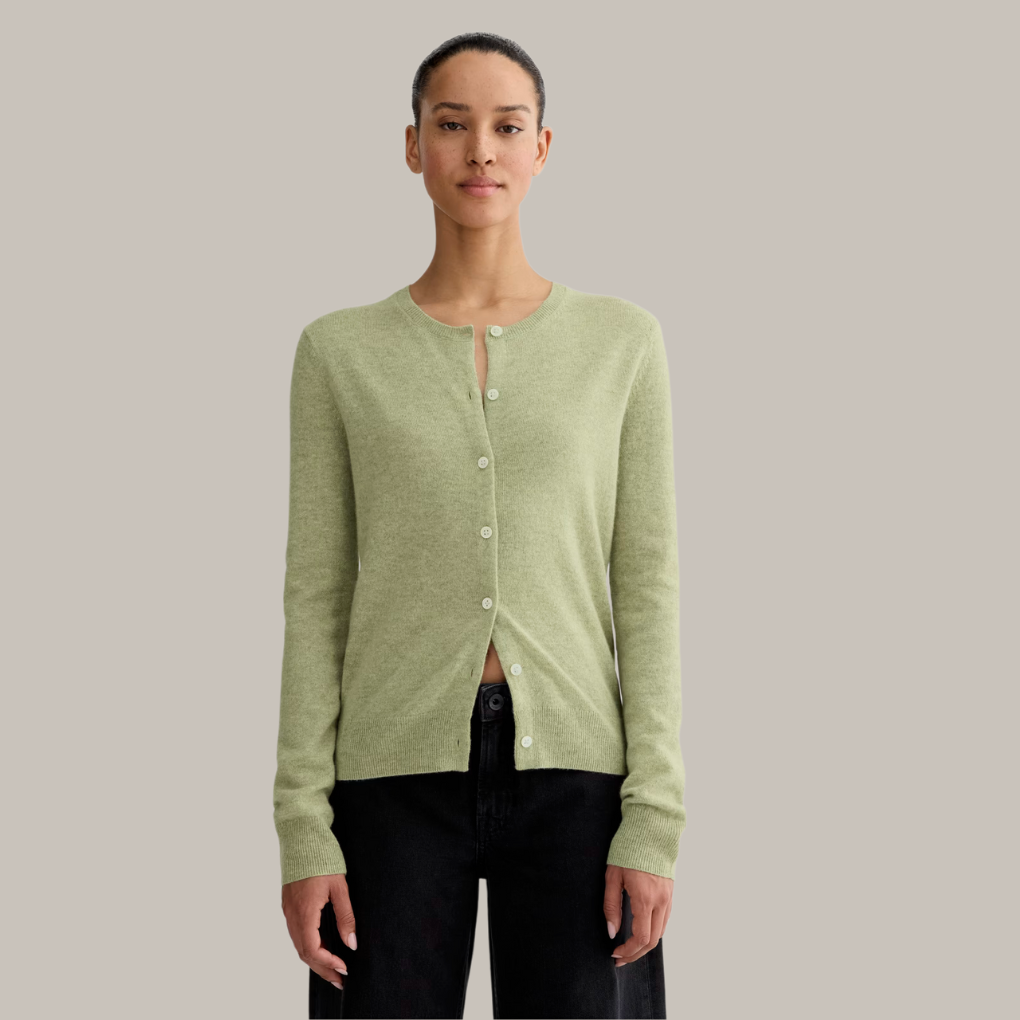
Eileen Fisher
$348
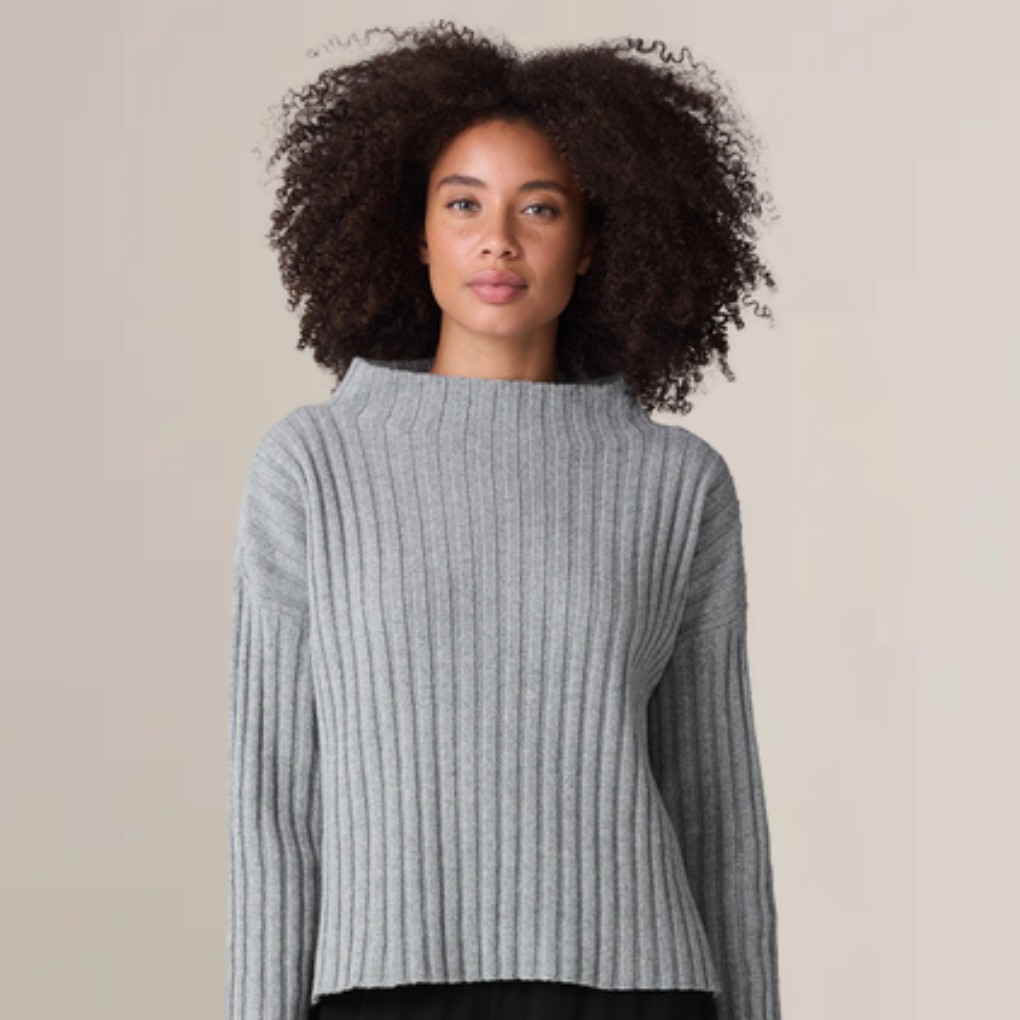
An American women’s fashion brand founded in 1984 in New York by designer Eileen Fisher with just $350 in startup capital.
Starting as an interior and graphic designer who struggled to find clothes she wanted to wear, Fisher created a system of four simple, timeless pieces designed to work together effortlessly, revolutionizing the concept of a functional wardrobe.
Why we love them
- Certified B Corporation since 2015 with 109.4 impact score (median is 50.9)
- Pioneering Renew take-back program – collected over 2 million garments since 2009
- Waste No More program transforms old clothes into felted fabric for new designs
- First fashion company to introduce bluesign® certified responsibly-dyed silk (2012)
- Responsible Wool Standard-certified and Global Recycled Standard-certified materials
- Circular design approach with resale, remake, and recycling programs
- Material: 80% Recycled Wool, 20% Recycled Cashmere
- Certifications: B Corporation, Global Recycled Standard (GRS), Responsible Wool Standard (RWS), Bluesign® certified materials
How to Tell if a Sweater Is Truly Sustainable
With more brands leaning into eco-friendly marketing, it’s getting harder to know what’s sustainable and what’s just clever packaging. If you’re investing in a sweater you plan to wear on repeat, here’s how to make sure it lives up to the label.
Look for Recognized Certifications
Certifications aren’t perfect, but they’re one of the most reliable ways to verify sustainability claims. A few to keep an eye out for:
- GRS (Global Recycled Standard): Confirms that recycled materials are authentic and that environmental and social practices were followed during production.
- RWS (Responsible Wool Standard): Ensures wool is sourced from farms that prioritize animal welfare, land health, and supply chain traceability.
- OEKO-TEX Standard 100: Verifies that the finished product is free from harmful substances and safe for human use. Especially helpful for sensitive skin.
- Bluesign®: Focuses on responsible manufacturing and chemical safety throughout the textile process.
Check for Supply Chain Transparency
Brands that are genuinely committed to sustainability usually tell you exactly where and how their sweaters are made. Look for details about where the wool was sourced, where the yarn was spun, and which factory produced the final garment. Vague phrases like “ethically made” or “eco-friendly” without further explanation are red flags.
Look for Third-Party Testing or Traceability Tools
Some companies go beyond certifications and offer tools that let you trace your sweater from fiber to final stitch. Others share lab testing or life cycle assessments to back up their claims. These extras show a deeper level of commitment.
Watch Out for Greenwashing
Buzzwords like “eco yarn,” “sustainably inspired,” or “natural blend” might sound promising, but without proof, they don’t mean much. If a product sounds sustainable but doesn’t say how, dig deeper—or move on to a more upfront brand.
Related Article: Beyond Greenwashing: The Third-Party Certifications That Prove Brand Claims
tips
Care for Recycled Material Sweaters
One of the best ways to make your sustainable sweater even more sustainable? Take care of it. Recycled wool and cashmere are just as cozy as their virgin counterparts, but they do benefit from a little extra love. Here’s how to keep your favorites looking great season after season.
- Wash Sparingly: Wool and cashmere don’t need to be washed after every wear. Often, a gentle airing out is all it takes. When it’s time to clean, hand wash in cold water with a mild, wool-safe detergent. Avoid wringing—press water out gently and lay flat to dry.
- Use a Cashmere Comb or Sweater Stone: Pilling is normal, especially in soft knits. A cashmere comb or sweater stone can easily remove pills without damaging the fibers. Regular de-pilling helps keep your sweater looking smooth and fresh.
- Store Folded, Not Hung: Always fold wool and cashmere sweaters. Hanging them can stretch out the shoulders and distort the shape over time. For off-season storage, use a breathable cotton bag or bin with a natural moth repellent like cedar or lavender.
- Longevity Is Part of the Sustainability: The longer a garment lasts, the more sustainable it becomes. With proper care, recycled sweaters can stay in rotation for years, saving resources and keeping textiles out of landfills. A little maintenance goes a long way toward keeping both your wardrobe and the planet in good shape.
This Has Been About
Fall fashion doesn’t have to come at the planet’s expense. Choosing a recycled sweater over a fast fashion impulse buy might seem like a slight shift, but multiplied across millions of wardrobes, it makes a real difference.
Recycled wool and cashmere sweaters reduce waste, conserve resources, and give discarded materials a second life, all while keeping you warm and stylish. These aren’t just clothes. They’re part of a slower, more intentional way of dressing that supports both people and the planet.
Related Article: The Power of Conscious Fashion: How to Make Better Clothing Choices
Featured image from Baukjen.
